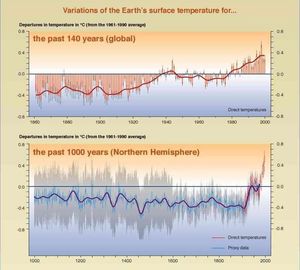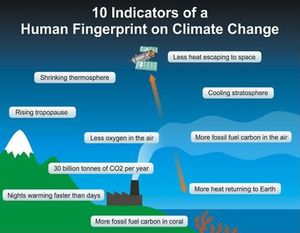Climate change
Global warming and climate change refer to an increase in average global temperatures and its effects on the local weather and climate.[1] Fig.1 shows the historical trend of global and north hemisphere surface temperature variations. Natural events and human activities are believed to be contributing to an increase in average global temperatures.[2] According to IPCC (AR4,WGI), "most of the observed increase in global average temperatures since the mid-20th century is very likely due to the observed increase in anthropogenic greenhouse gases concentrations". Greenhouse gases such as Carbon Dioxide (CO2), methane and nitrous oxide, act like a blanket surrounding the earth, keeping the heat supposed to escape into the outer space in and then warming the earth. It is observed that the concentration of man-made "greenhouse" gases have increased markedly as a result of human activity since 1750 and now far exceed pre-industrial values.[3] John Cook, writing the popular Skeptical Science blog summarizes the key indicators of a human finger print on climate change.

Fig.1 Variations of the global and Northern hemisphere temperature (http://www.ipcc.ch/present/graphics.htm)
The effects of climate change may be physical, ecological, social or economic. Due to the global warming and climate change, the hydrological cycle of precipitation and evapo-transpiration will change. The frequency of extreme weather, like drought, heavy rainfall, floods and tropical cyclones will increase in some areas. The decreased volume of mountain and oceanic glaciers and snow cap has contributed to the observed sea level rise,[2] IPCC (AR4,WGI) reported that since 1961, global average sea level had risen at an average rate of 1.8 [1.3 to 2.3] mm/yr. The socio-economic impact of climate change is mainly embodied in the effect on food production and on human health.[4] Generally, low-latitude areas are at most risk of having decreased crop yields. Food supply, heat stress, poor air & water quality and flooding will all have their impact on public health.

Fig. 2: John Cook, 10 indicators of a human fingerprint on climate change, Skeptical Science, July 30, 2010
In terms of water management, climate change not only leads to the need of strengthening flood protection, but also to making urban, agricultural and environmental systems more drought and heat resilient.
Projects at Water Resources Management that involve climate change include:
Effect of Climate Change on Urban Water Management Design Criteria
References
[1] http://www.ipcc.ch/publications_and_data/ar4/wg1/en/spm.html
[2] Intergovernmental Panel on Climate Change (IPCC). "Summary for Policymakers". in Solomon 2007.
[3] http://www.skepticalscience.com/10-Indicators-of-a-Human-Fingerprint-on-Climate-Change.html
http://www.youtube.com/watch?v=S9ob9WdbXx0&feature=player_embedded#, the truth of climate change
[4] Schneider, S.H., et al. "Assessing key vulnerabilities and the risk from climate change". in Parry 2007, p. 781. http://www.ipcc.ch/publications_and_data/ar4/wg2/en/ch19.html.